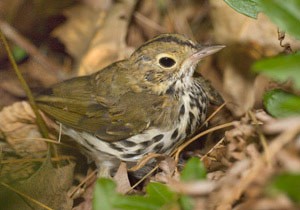A considerable amount of research has been conducted about the impact of timber management on bird habitat, but few if any scientific studies have examined how management for non-timber forest products affects birds. Steve Hagenbuch, a conservation biologist for Audubon Vermont, was curious about the bird populations in managed maple sugarbushes, so he examined this topic for his master’s thesis at Antioch University New England.
Although management practices varied somewhat, the vegetative structure and composition of the 10 sugarbushes he studied were all quite similar. While sugar maples were predominant, the sugarbushes all contained a mix of beech, yellow birch, and other tree species, and there was a surprisingly dense understory. There was also no statistical difference in other variables,
like occurrence of snags, percent leaf litter, or canopy cover.
Correspondingly, the bird species present were quite similar from one sugarbush to the next. Not surprisingly, ovenbirds and red-eyed vireos, both of which prefer closed canopy deciduous forest, were the most abundant species Hagenbuch recorded. But Hagenbuch also noticed black-throated blue warblers, which only nest in low, dense vegetation generally within three feet of the ground.
“Not all the birds in these sugarbushes were mature-forest species,” said Hagenbuch. “There were places where we found early-successional species, like chestnut-sided warbler or mourning warbler, which might seem surprising. But there were pockets where the canopy was sufficiently open enough to create a dense enough understory to provide marginal breeding habitat for these early successional birds.”
Of particular note, Hagenbuch found that the greater the percentage of maple in a sugarbush, the less diversity and abundance of birds were found. Given that sugarbush management is geared toward making maple the dominant species, he said that this is a significant finding. “It speaks to the need to manage against maple monoculture if bird habitat is an additional objective,” he said.
On the other hand, the study found that a high percentage of the bird species in sugarbushes are priority species for conservation in the northern forest region, including eastern wood peewee, black-throated green warbler, and American redstart, in addition to ovenbird and black-throated blue warbler. “So even though the number of species and total number of birds may be decreased in maple sugarbushes when compared with a more diverse stand, many of the species that are there are of high conservation interest. Therefore, sugarbushes do appear to have high bird conservation value,” Hagenbuch said.
If a sugarmaker wishes to encourage birds in his or her sugarbush, Hagenbuch recommends retaining yellow birch trees, which are preferred by insect-eating birds for foraging.


